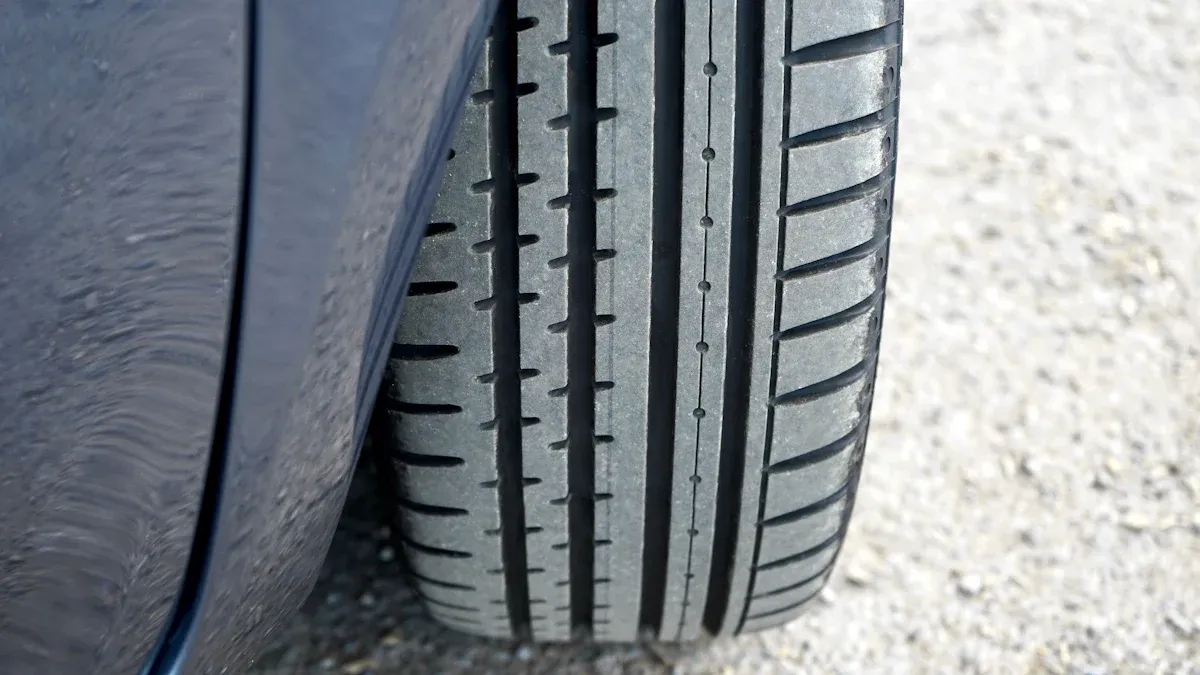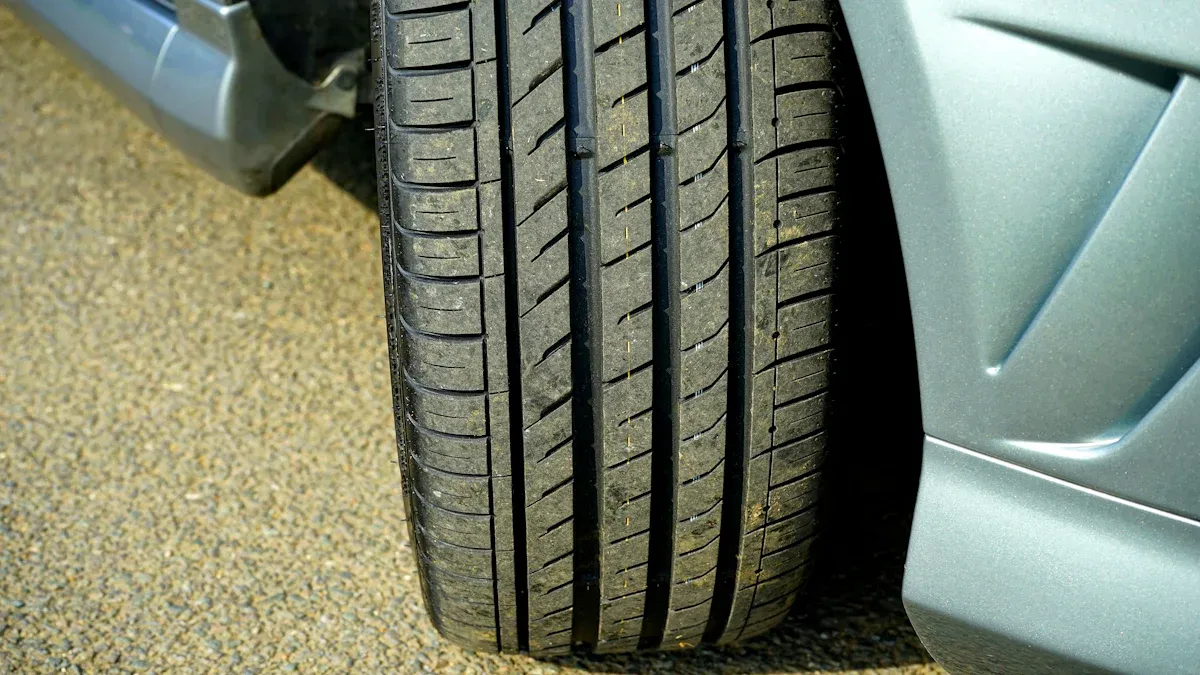
When the edges of tire are worn, it can significantly impact your vehicle’s safety and performance. Worn tire edges often lead to reduced handling and stability, making driving more challenging. This type of wear can also result in longer stopping distances, particularly on wet or slippery roads. Research indicates that maintaining proper tire inflation and suspension systems is crucial to prevent the edges of tire are worn. Regularly inspecting your tires helps ensure safer driving and extends the life of your tires.
핵심 요약
Tires that are not inflated enough wear out faster on the edges. Check your tire pressure often to keep it right.
Wheels that are not aligned cause uneven tire wear and steering issues. Get your alignment checked every 7,000 to 12,000 miles or after hitting potholes.
Worn-out suspension parts make tires wear unevenly and can be unsafe. Check and fix suspension problems quickly.
Look for signs like uneven wear, feathering, or cupping on tire edges. Catching these problems early can prevent bigger damage.
정기적인 타이어 관리 and professional checks help your tires last longer. This also improves safety and keeps your vehicle running well.
Causes of Tire Edge Wear

Underinflation
Underinflation is a main reason for tire edge wear. When your tires do not have enough air, they change shape. This change makes the edges sag and touch the road more. Because of this, the outer edges wear out faster than the middle. Tire makers say keeping the right tire pressure is very important. Checking your tire pressure often can help stop this problem.
Key Points:
Underinflated tires wear out the outside edges faster.
Keeping tire pressure in the right range is key.
Regular checks can help stop uneven tire wear.
Misalignment
Misalignment happens when your car’s wheels are not straight with each other or the ground. This can happen from hitting potholes, curbs, or just normal use. Misalignment changes how your tires touch the road, causing uneven wear. For example, too much toe-in can make the outside edge wear faster, leading to uneven patterns.
Common Signs of Misalignment:
Feathering, where the tread feels smooth one way and rough the other.
Steering pulls to one side while driving.
To avoid misalignment, check your tire alignment often, especially after hitting something hard or every 12,000 miles normally.
Worn Suspension Components
Worn suspension parts can also cause tire edge wear. When parts like control arms, tie rods, or shocks wear out, they can make the wheels unstable. This instability leads to uneven tire wear. For example, worn shocks can cause cupping or scalloping on the tire tread, speeding up edge wear.
Symptoms of Worn Suspension:
Loose steering or noise from the suspension.
Extra wear on the inner or outer edges of tires.
Regularly checking your suspension system can help find these problems early. Fixing worn parts quickly can stop more damage and keep your vehicle safe to drive.
By knowing these causes of tire edge wear, you can take steps to care for your tires. Regular checks on tire pressure, alignment, and suspension parts will help your tires last longer and improve your vehicle’s performance.
Identifying When the Edges of Tire Are Worn

Knowing when the edges of your tires are worn is very important for keeping your vehicle safe and working well. You can look at your tires closely and check for signs of uneven wear to see how they are doing.
Visual Inspection Techniques
Looking at your tires can help you find edge wear early. Here are some good ways to check, as suggested by tire makers:
High-Resolution Cameras: Use cameras with at least 12 megapixels. They take clear pictures of your tire surfaces. This helps find problems like edge wear.
Laser Sensors: Use laser tools that gather 3D data about your tire surfaces. This data can be turned into 2D images for better checking.
Advanced Image Processing: Use methods like polar transforms to help find edges better by fixing any distortions.
Machine Learning Algorithms: Use smart programs like convolutional neural networks (CNN) to look at pictures and find problems easily.
Background Optimization: Make sure the area around the tire is clear. This helps you see edge wear better.
Calibration Processes: Regularly check your tools to fix any errors. This makes your edge wear checks more reliable.
By using these methods, you can keep an eye on your tires and find problems before they get worse.
Signs of Uneven Wear Patterns
편평한 타이어 마모 can show that there are problems with your vehicle. Here are some signs to look for:
Uneven Tire Wear Pattern | Common Causes |
|---|---|
Wear on outer/inner edges | Misalignment, underinflation |
Wear on center of tire | Overinflation |
Heavy wear on one side | Misalignment, suspension issues |
Irregular or patchy wear | Suspension problems, aggressive driving habits |
Cupping (scalloped dips) | Worn shocks or struts |
Feathering (feather-like edges) | Improper alignment |
If you see any of these patterns, you should check further. For example, if the edges of your tires are worn a lot, it might be due to underinflation or misalignment. Regularly checking your tire pressure and alignment can help stop these problems.
By being careful and checking often, you can keep your tires in good shape. This helps your vehicle work better and keeps you safe on the road.
Preventive Measures for Tire Edge Wear
Regular Tire Maintenance
You can do many things to take care of your tires and stop edge wear. Regular maintenance is very important for keeping your tires healthy. Here are some good ways to help:
Check Tires Often: Look at your tires regularly for cracks, cuts, and uneven wear. Check for any debris stuck in the tires that could cause harm.
Keep Tire Pressure Right: Use a gauge to check your tire pressure every 2 to 4 weeks. Change the pressure based on how much weight your vehicle carries and the road conditions.
Make Sure Wheels Are Aligned: If your wheels are not aligned, it can cause uneven wear. Get your alignment checked every 7,000 miles or after hitting a pothole.
Rotate Tires Often: Change the position of your tires every 5,000 to 8,000 miles. This helps them wear evenly and last longer.
Clean Your Tires: Take off dirt, oil, and debris from your tires. This helps stop early wear and damage from chemicals.
Replace Worn Tires Quickly: If your tread depth is too low or you see damage, get new tires right away.
Learn to Drive Smoothly: Practice driving gently. Avoid sudden stops, sharp turns, and carrying too much weight to reduce stress on your tires.
By doing these things, you can lower the chance of tire edge wear and improve how your vehicle works.
Importance of Professional Inspections
Even though you can do basic tire care, professional inspections are very important for finding early signs of edge wear. Here’s why you should think about them:
Special Tools: Professionals use precise tools to check alignment and suspension angles. They can find problems that you might miss.
Complete Checks: Certified technicians look at your tires’ overall health, spotting small wear patterns and misalignment early.
Preventive Care: Regular professional checks help you find issues before they get worse, saving you money on big repairs.
Expert Advice: Technicians can give you specific tips based on your vehicle’s needs and how you drive.
By mixing your own checks with professional evaluations, you create a strong maintenance plan. This helps your tires last longer, stay safe, and perform better, keeping you safe on the road.
Knowing why tire edge wear happens is very important for your vehicle’s safety and how well it works. Main reasons include underinflation, misalignment, and worn suspension parts. Regular maintenance is key to stopping these problems.
Take proactive steps to care for your tires:
Rotate your tires every 5,000 to 8,000 miles.
Schedule professional inspections to find problems early.
By doing these things, you can improve your vehicle’s safety and make your tires last longer. Remember, when the edges of tire are worn, it can cause serious driving dangers. Stay alert and keep your tires in great shape!
FAQ
What causes tire edge wear?
Tire edge wear mostly happens because of low air pressure, misalignment, and worn-out suspension parts. These issues make the tires touch the road unevenly, which makes the edges wear out faster.
How can I check my tire pressure?
You can check your tire pressure with a tire pressure gauge. First, take off the valve cap. Then, press the gauge onto the valve stem and read the pressure. Compare this number to what is recommended in your vehicle’s manual.
How often should I rotate my tires?
You should rotate your tires every 5,000 to 8,000 miles. This helps all tires wear evenly, which makes them last longer and improves how your vehicle drives.
What are the signs of misalignment?
Common signs of misalignment are uneven tire wear, the steering wheel pulling to one side, and a crooked steering wheel when driving straight. If you see these signs, get your alignment checked.
Why are professional inspections important?
Professional inspections are very important because experts use special tools to find problems you might not see. They can spot early signs of wear and misalignment, helping you avoid expensive repairs later.






